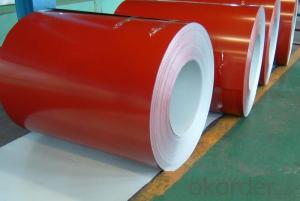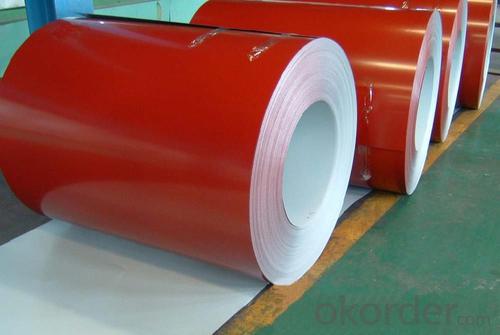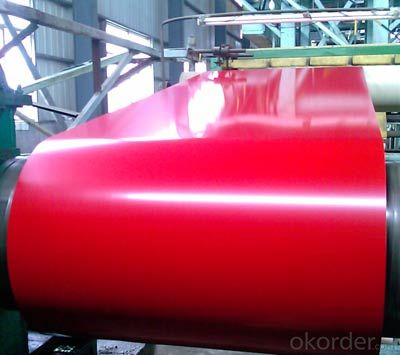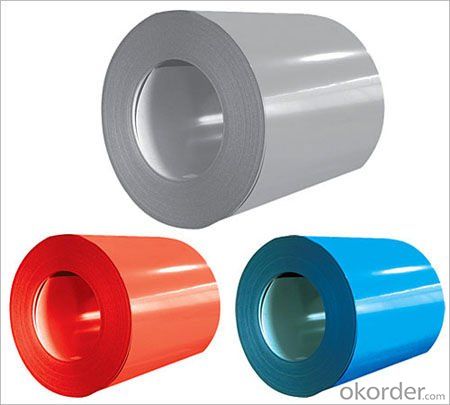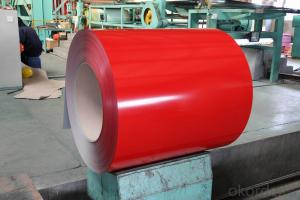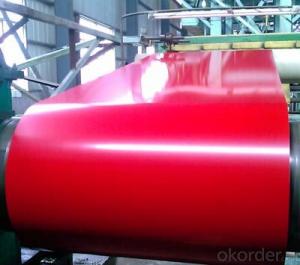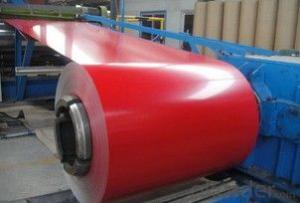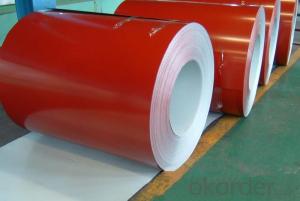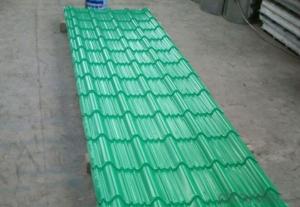Prepainted Galvanized Steel Coil with lowest price in red
- Loading Port:
- Shanghai
- Payment Terms:
- TT OR LC
- Min Order Qty:
- 100 m.t.
- Supply Capability:
- 10000 m.t./month
OKorder Service Pledge
OKorder Financial Service
You Might Also Like
1. Pre-Painted Galvanized/Aluzinc Steel Coil Description:
Pre-painted galvanized steel is good capable of decoration, molding, corrosion resistance.
It generally displays superior workability, durability and weather resistance.
2.Main Features of the Pre-Painted Galvanized/Aluzinc Steel Coil:
• Excellent heat resistance performance
• High strength
• Good formability
• Good visual effect
• Excellent process capability
• Smooth and flat surface
• Workability, durability
3.Pre-Painted Galvanized/Aluzinc Steel Coil Images
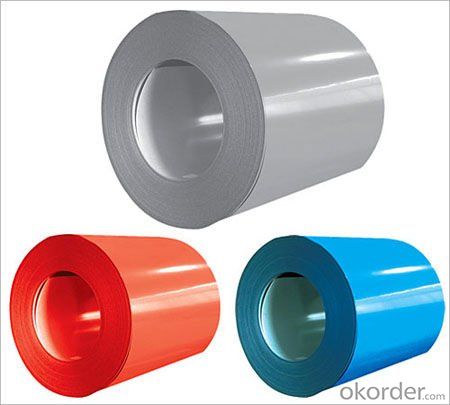
4.Pre-Painted Galvanized/Aluzinc Steel Coil Specification
Standard: AISI, ASTM, BS, DIN, GB, JIS
Grade: DX51D, DX52D
Thickness: 0.17-2.0mm
Brand Name: KMRLON
Model Number: coil
zinc coating: 40-180g/m2
printing thickness: top side: 20+/-5 microns, back side: 5-7 microns
color: all RAL color
surface treatment: color coated
coil weight: 4-7 tons
coil ID: 508/610mm
packaging: standard seaworthy packing
5.FAQ of Pre-Painted Galvanized/Aluzinc Steel Coil
1. What’s the application of this product?
Roof, roof structure, surface sheet of balcony, frame of window, etc.
2. What’s the brand of the paint?
We use the best brand of all of the word—AKZO.
- Q: Can steel coils be used in the production of agricultural equipment?
- Yes, steel coils can be used in the production of agricultural equipment. Steel coils are often used as a raw material in the manufacturing of various agricultural equipment such as plows, planters, harvesters, and tillers. The high strength and durability of steel make it suitable for heavy-duty applications in agriculture. Additionally, steel coils can be easily shaped and formed into different parts and components required in agricultural machinery. The corrosion resistance of steel also ensures that the equipment can withstand harsh weather conditions and prolong its lifespan. Overall, the use of steel coils in the production of agricultural equipment helps in ensuring the reliability, longevity, and efficiency of the machinery used in farming operations.
- Q: What are the different types of steel coil cutting methods?
- There are several different types of steel coil cutting methods, including slitting, shearing, and laser cutting. Slitting involves cutting the coil into narrower strips using rotating circular knives. Shearing is the process of cutting the coil using straight blades to create straight edges. Laser cutting uses a focused laser beam to melt and vaporize the steel, resulting in a precise and clean cut.
- Q: I'm sort of a sword maker. You could say I'm an amateur blacksmith. I want to find a dependable source of high-grade steel. I've made a few blades and from what I know about the difference between true steel and cheap steel, I have yet to work with such. All of the metal I have used could not have been true high carbon spring steel because while they are hard, their properties do not reflect that of true steel. I would sincerely appreciate any guidance on where I could order some fine-quality steel so I could produce a truly fine blade.
- The phrase true steel has no technical meaning. Steel comes in many alloys and grades. Sorry I have no idea where to get different grades and types of steel. McMaster Carr carries a lot of steel bars, sheets, etc.
- Q: My daughter wants a pair of steel toe cap boots for around the horses but wants them warm, so ideally fur lined etc. Does anybody know where I could purchase them as everywhere I look its only one or the other, cant get steel with fur lining. Very frustrating. I live in the uk. Many thanks.
- TRY FINDING A GOOD PAIR OF WOOL SOCKS. MOST OUTDOOR STORES LIKE BIG 5, DICK'S OR BASS PRO SHOPS CARRIE A GREAT SELECTION OF WINTER STOCK.
- Q: How are steel coils used in the production of oil and gas machinery?
- Steel coils are used in the production of oil and gas machinery as they provide essential structural support and reinforcement. These coils are typically formed into various components such as pipes, tubes, and casings, which are crucial for drilling, extraction, and transportation processes in the oil and gas industry. The strength and durability of steel coils ensure the reliability and longevity of the machinery, allowing for efficient and safe operations in the oil and gas sector.
- Q: how much pressure can steel withstand? and how much pressure can concrete withstand? per m3 or cm3? thanks
- A common allowable stress for steel is 24,000 psi for A36 steel. Note that allowable stress is a working stress that is less than ultimate stress the stress at which the material will rupture. This allowable stress keeps the steel within the elastic range. Concrete allowable stress is typically around 3000 psi. Concrete, though, being a mixed material has variable values for allowable stress. Reinforced concrete design theory suggests that concrete should not be considered to be able to carry much, if any, tensile force. This explains why you will see steel rebar or reinforcing bars cast in to the concrete. The steel is there to carry any tensile forces, while the concrete is there to carry compression forces. This is a VERY basic explanation. There are entire books on both of these subjects...
- Q: How are steel coils inspected for straightness?
- Steel coils are typically inspected for straightness using various methods such as visual inspection, laser measurement, or by passing the coils through straightening equipment.
- Q: does he use a nylon guitar or steel?
- The correct term for what you are looking at is a classical guitar. Classical guitars always have nylon strings (steel strings will tear them apart). There is no such thing as a nylon guitar, and if there were, I don't think it would sound very good, although Mario Maccaferri did make some plastic ones that are quite collectible now. Steel guitar - as opposed to steel-string guitar which is what I think you mean - is the name of an entirely different instrument that doesn't look much like a guitar at all. There are also steel-bodied guitars which have a mechanical amplification system built in. However, normal classical and steel-string guitars are made of wood. A classical guitar usually has a slotted headstock with wide rollers, a wide uncambered fretboard, a 12-fret neck, an ornate soundhole rosette, no pickguard, a tied bridge with a straight saddle, and fan bracing. A steel-string guitar usually has a solid headstock or a slotted headstock with narrow rollers, a narrow cambered fretboard, a 14- or 12-fret neck, a simple rosette, a pickguard, a pin bridge with a slanted saddle, and X bracing.
- Q: Specifically, for the main support beam found in a basement.
- Talk to the supplier of both the products on what is involved in installation, weight bearing over the span you are trying to go without supports,the size of beam, will it affect the height of the room below or will the floor have to go up and the cost how much are you prepared to spend, you will then get your answer
- Q: How are steel coils used in the manufacturing of HVAC systems?
- Steel coils are used in the manufacturing of HVAC systems as they serve as the primary heat transfer component. The coils are designed to efficiently transfer heat between the air and refrigerant, allowing for effective cooling or heating of the space.
Send your message to us
Prepainted Galvanized Steel Coil with lowest price in red
- Loading Port:
- Shanghai
- Payment Terms:
- TT OR LC
- Min Order Qty:
- 100 m.t.
- Supply Capability:
- 10000 m.t./month
OKorder Service Pledge
OKorder Financial Service
Similar products
Hot products
Hot Searches
Related keywords
